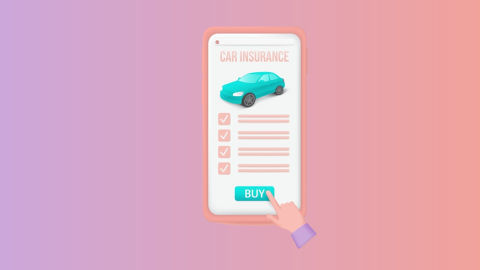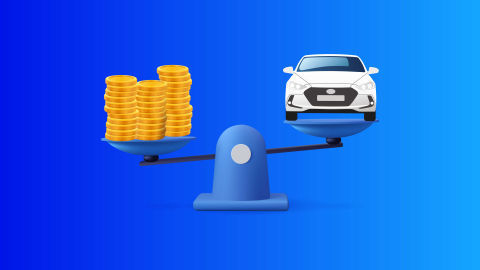Factors that help determine your car's IDV
The IDV is an important factor in determining the premium of a car insurance policy. Hence, it is essential to choose the right IDV in insurance to avoid overpaying or underinsuring your car using an IDV calculator. The IDV of a car depends on several factors, including:
• Age and depreciation of the car
As the car ages, its value depreciates, and hence, the IDV in car insurance also decreases. The depreciation value of a car increases with its age.
• Make and model of the car
The make and model of the car determine its IDV. Different car brands have different values, even if they are of the same segment.
• Fuel type
The fuel type of the car affects IDV in car insurance. For instance, diesel cars usually have a higher IDV than petrol cars due to their higher selling price.
• Geographical location
The location of the car also plays a role in determining the IDV. Cars located in urban areas may have a higher IDV due to the higher cost of living and higher car prices.
• Modifications and accessories
Any modifications or accessories added to the car will increase its value and reflect on the IDV.
• Condition of the car
The overall conditions of the car, including its mileage, wear and tear, and maintenance, affect the IDV. You can check the IDV by mentioning all these things while using the IDV calculator.
Pros and cons of high/low IDV
Here are the pros and cons of having a high or low IDV:
Type of IDV
|
Pros
|
Cons
|
High IDV
|
High IDV ensures that you get adequate coverage for the full value of your car.
|
High IDV results in a higher premium for your car insurance policy.
|
High IDV increases the resale value of your car.
|
The insurer will pay a lesser amount in case of a claim because of the high depreciation value.
|
Low IDV
|
Low IDV results in a lower premium.
|
You get coverage amount based on the car’s IDV, which may not cover the car’s full value during total loss or theft.
|
A lower IDV will cover the current resale value of your car adequately.
|
You may have a lower depreciation value of the car. The IDV calculator will provide detailed information about the same.
|
Standard car depreciation rate for IDV calculation
The Insurance Regulatory and Development Authority of India (IRDAI) determines the rate of depreciation for motor insurance.
Age of the vehicle
|
Depreciation for IDV in %
|
Up to 6 months
|
5%
|
6 months – 1 year
|
15%
|
1 – 2 years
|
20%
|
2 – 3 years
|
30%
|
3 – 4 years
|
40%
|
4 – 5 years
|
50%
|
- For vehicles up to 6 months old: No depreciation applied, IDV in insurance considered as per the manufacturer's selling price.
- For vehicles between 6 months and 1 year old: The rate of depreciation is 5% of the IDV.
- For vehicles between 1 year and 2 years old: The rate of depreciation is 10% of the IDV.
- For vehicles between 2 years and 3 years old: The rate of depreciation is 15% of the IDV.
- For vehicles between 3 years and 4 years old: The rate of depreciation is 25% of the IDV.
- For vehicles between 4 years and 5 years old: The rate of depreciation is 35% of the IDV.
- For vehicles between 5 years and 10 years old: The rate of depreciation is as per the mutual agreement between the insurer and the insured.
- For vehicles over 10 years old: The IDV is mutually agreed upon between the insurer and the insured.
The vehicle's parts and accessories also have a depreciation value. Choose the right IDV for your motor insurance policy to ensure adequate coverage in case of total loss or theft. Make sure to provide the entire detail of the vehicle while calculating the insured declared value on the IDV calculator.
What are the components of Car Insurance IDV?
The Insured Declared Value (IDV) in car insurance is determined by the following components:
Age of the vehicle
Older vehicles generally have a lower IDV due to depreciation.
Make and model
The brand, model, and variant of the car affect its IDV.
Accessories
Any additional accessories installed in the vehicle can impact its IDV.
Market value/showroom price
The current market value of the car serves as a crucial component of the IDV calculation.
Cubic capacity
Vehicles having engines with higher cubic capacity (cc) have a higher market value. This again has an impact on its IDV.
Depreciation
IDV considers depreciation based on the car's age and condition.
Understanding these components is essential for accurately calculating the IDV using an IDV calculator.
What happens if you choose a lower IDV?
If you decrease the IDV of your car, your policy premium will decrease, leading to savings on your car insurance. But this will also give you a lower coverage amount, resulting in less compensation in case of total loss.
What happens if you choose a higher IDV?
If you choose a higher IDV for your car, the sum insured on the car insurance policy will increase. You will get adequate coverage for your car in case of total loss or theft. Nonetheless, the premium of the car insurance policy will also increase.
Why do you need to care about the car’s IDV?
As mentioned above, IDV impacts on your car insurance premium and its coverage. You get maximum coverage for your car in case of total loss, theft, or repair based on the IDV in car insurance. It also helps you get a good resale value for your car. The higher the IDV, higher the resale price.
Impact of IDV on car insurance policy
The Insured Declared Value (IDV) directly impacts the premium amount in car insurance. Here's how:
Higher IDV, higher premium
A higher IDV implies greater coverage and higher compensation in case of damage or loss, leading to a higher premium.
Lower IDV, lower premium
Conversely, lower IDV results in reduced coverage and lower compensation, leading to a lower premium.
Accuracy in calculation
Using an IDV calculator ensures an accurate assessment of the vehicle's value, enabling policyholders to choose the right coverage level and premium amount.
Balancing coverage and cost
Balancing IDV with premium cost is crucial to ensure adequate coverage without overpaying for insurance.
Understanding the correlation between IDV and premium helps policyholders make informed decisions while purchasing car insurance.
Advantages and disadvantages of decreasing IDV (Low IDV)
Lowering the Insured Declared Value (IDV) of your vehicle can impact your insurance premium and claim amount.
Advantages:
- Reduced premium: Lower IDV results in lower insurance premiums.
- Cost-effective for older vehicles: Suitable for older vehicles with lower market value.
- Savings: Provides a way to save money on annual insurance costs
Disadvantages:
- Lower claim amount: In case of total loss or theft, the claim amount will be significantly lower.
- Insufficient coverage: May not cover the actual repair costs in case of major damage.
- Potential risk: Could be risky if unexpected high repair costs arise from accidents.
Advantages and disadvantages of increasing IDV (High IDV)
Increasing the IDV of your vehicle can provide better coverage but at a higher cost.
Advantages:
- Higher claim amount: Ensures higher compensation in case of total loss or theft.
- Comprehensive coverage: Offers better protection for newer or high-value vehicles.
- Better financial security: Covers more of the repair costs, reducing the financial burden after an accident.
Disadvantages:
- Higher premium: Leads to increased insurance premiums.
- Over-insuring: May result in unnecessary high costs without proportional benefits.
- Diminished returns: Higher premiums may not be justifiable for older or depreciated vehicles.
When should you buy a car insurance policy with a lower IDV?
Opt for a lower IDV when the vehicle is older and its market value has significantly depreciated, ensuring a balance between premium costs and coverage. Use an IDV calculator to determine the appropriate IDV, considering factors such as the age, condition, and usage of the vehicle.
- Older vehicles: When the vehicle is several years old and has a low market value.
- Minimal use: If the car is not used frequently, minimising the risk of accidents.
- Tight budget: When managing insurance costs is a priority over comprehensive coverage.
By understanding the IDV meaning in insurance and utilising tools like an IDV calculator, you can make informed decisions about the IDV in insurance that best fits your financial situation and coverage needs.
Now that you know how to calculate the insured declared value by IDV calculator and how it plays a role in insurance, you can look for a car insurance online. Bajaj Finance Insurance Mall hosts a range of car insurance policies, where you can compare and buy car insurance of your choice. Bajaj Finance offers a 100% buy process, enabling you to buy the policies hassle-free.
Links to some motor insurance related topics





